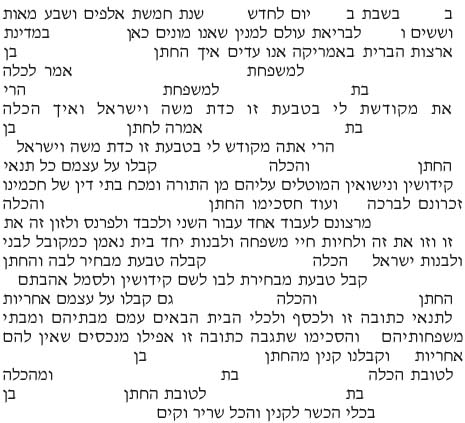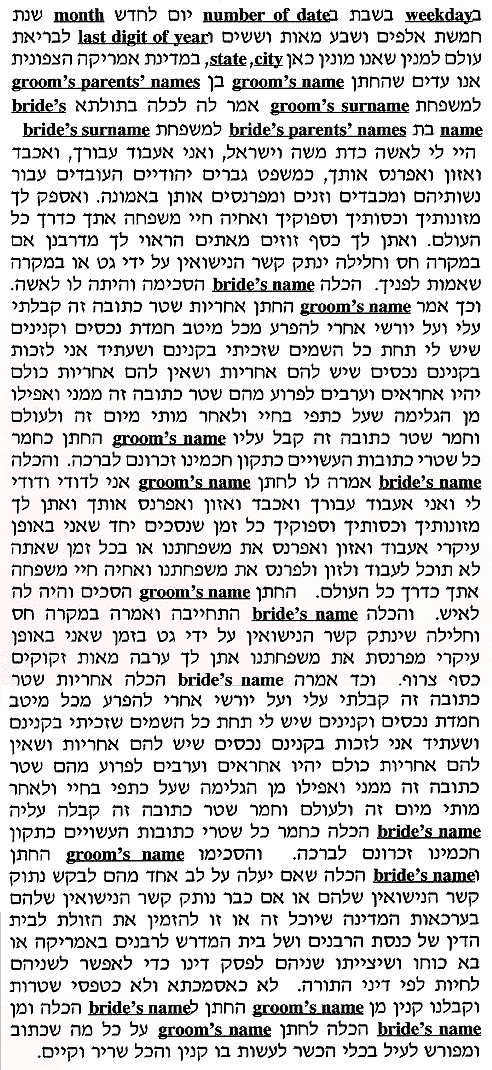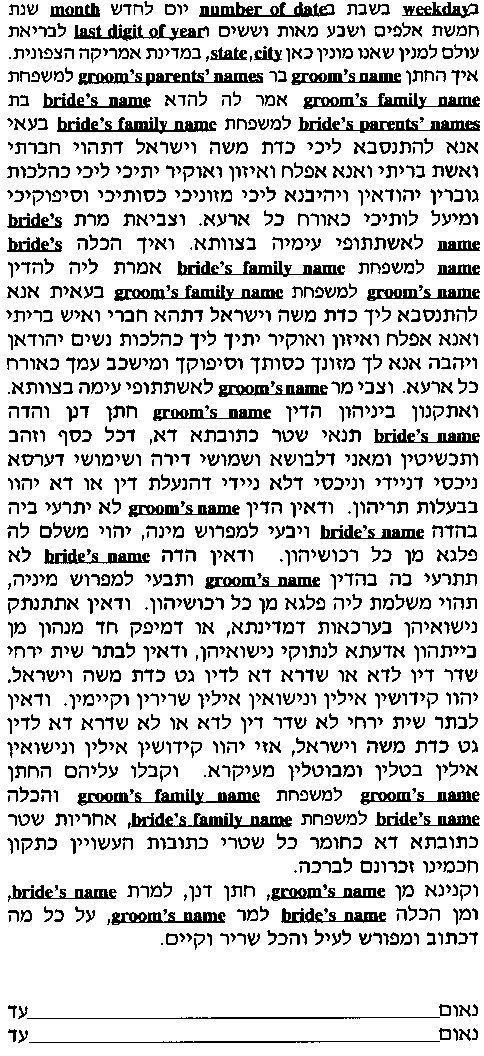- Traditional Texts
- Traditional Egalitarian Texts
- Modern Texts
- Covenant Texts
- Interfaith Texts
- Same Gender Texts
- Secular Texts
Traditional Egalitarian Texts
Conservative Alternative
We witness that on the day of the week, the day of the month of , in the year , corresponding to the day of , , here in , the groom, , son of , said to the bride, , daughter of , “You are consecrated to me as my wife, with this ring, according to the laws of Moses and Israel,” and that the bride, , said to the groom, , “You are consecrated to me as my husband with this ring, according to the laws of Moses and Israel.” The groom and the bride accepted all the conditions of betrothal and marriage as set forth by biblical law and by the rulings of the Sages of blessed memory. The groom and bride further agreed willingly to work for one another, to honor, support, and nurture one another, to live with one another, and to build together a household of integrity as befits members of the Jewish people. The bride accepted a ring from the groom, and the groom accepted a ring from the bride, for the purposes of creating this marriage and to symbolize their love. The groom and bride also accepted full legal responsibility for the obligations herein taken on, as well as for the various property entering the marriage from their respective homes and families, and agreed that the obligations in this Ketubah may be satisfied even from moveable property. We have had both the groom and the bride formally acquire these obligations to the other, with an instrument fit for such purposes. Thus all is in order and in force.
Hebrew:
Conservative Egalitarian
The Conservative Egalitarian ketubah text was co-authored in Modern Hebrew by Rabbi Joel Schwab. It includes most of the Traditional Orthodox text but has several additions. The traditional text originates in Babylon. Originally it incorporated individual stipulations but it became standardized about 200 B.C.E. During the Gaonic period (mid-seventh to eleventh centuries), the Babylonian academies struggled for hegemony over their Palestinian counterparts. One of the results was the eradication of the Palestinian ketubah and the establishment of the standardized Babylonian ketubah in the practices of Jewish communities.
The Conservative Egalitarian ketubah text creates a halachic Jewish marriage. Several legal responsibilities detailed in the talmudic tractates kiddushin and ketubot are assumed but not written in the text. Another subtext is that traditional Jewish marriage is based upon the quality of Hesed, sometimes translated as lovingkindness. Hesed means a total shift of one’s concern from oneself to the other, eliminating sef-centeredness and replacing it with a genuine concern and identification with the pain and problems of those around us. In marriage, concern becomes focused primarily upon one’s spouse and children.
Several additions to the Traditional Orthodox text make this contract approach egalitarian. The text records that the groom proposes marriage and the brides accepts his proposal. The groom says: “Be mine in wifehood according to the laws and traditions of Moses and Israel”. This phrase enacts “kiddushin”, which is the act by which a man marries a wife. The bride makes her own proposal for the marriage and the groom accepts her proposal. The bride says: “I am my beloved’s and my beloved is mine”. This differs from “Be my wife”: her proposal of marriage is not quite the same as his proposal. As Rabbi Shevitz explains, according to the biblical basis of marriage and the structure of biblical Hebrew, a woman cannot enact kiddushin, meaning that she cannot perform the act of marrying a man. Another addition is that the bride promises to support and care for the groom at any and every time they mutually agree that she will be the principle provider. These statements echoe his promises.
The concluding lines of the Conservative Egalitarian ketubah text state that a kinyan is made from the groom to the bride and from the bride to the groom. Both bride and groom are changing their personal status according to this text. This departs from the Orthodox text by creating a bilateral contract. Feminists claim that kinyan refers to the acquisition of the bride by the groom (and, in this case, of the groom by the bride.) Rachel Adler writes: “kinyan [is] an act by which a subject unilaterally acquires specified rights over an object. Kinyan is essential in commercial transactions.” Traditionalists claim this is a misunderstanding of traditional Jewish marriage. As Moshe Meiselman explains, this contract is a “kinyan issur, a contract whose basic purpose is to effect a change in personal or ritual status furthermore, the word kinyan has been used metaphorically in biblical and rabbinic writings to indicate the establishment of a close and intimate relationship
Divorce can be initiated by both bride and groom according to the Conservative Egalitarian ketubah text. Further, this text adds a few lines to the Traditional text which make the marriage more financially equal in case of divorce. In the traditional text, the groom promises a divorce settlement to the bride of 200 zuzim. In this new text, bride and groom may mutually agree that she is the primary provider. Then, in case of divorce, she promises to pay him 400 zuzim. That is, she pays him back the 200 plus another 200. These amounts are traditional/ historical and do not really signify divorce settlement– that is determined by state law. By elaborating these provisions, however, the marrying couple is reminded that marriage and divorce entail financial consequences. In order for the divorce to be complete, one partner must send a Get and the other must willingly receive it. This text utilizes the Lieberman Clause as an attempt to solve the “agunah” problem. This clause was added as an addendum to the ketubah text by the Conservative Movement of Judaism in 1953. Saul Lieberman, the premier expert in Conservative Jewish Law at the time, framed the Aramaic formula. The purpose of this clause is to prevent the problem of one partner refusing to offer/ receive a Get in case of civil divorce. The Bet Din of the Rabbinical Assembly and the Jewish Theological Seminary of America is granted the authority to fix and determine the amount of money to be paid by the party refusing to grant a Get. The dispute can then be taken to the civil courts. In order to make this clause legally binding, the bride and groom should both sign the ketubah or a similar letter of intent which the Rabbi keeps in his files and sends to the Rabbinical Assembly to be kept in their files. Finally, the Conservative movement has been using an antenuptial procedure since this was created by the Rabbinical Assembly in 1968. This states that if no Get is sent within six months of the marriage being sundered by the courts of the State, or within six months of one of them leaving their home with the intent of sundering the marriage, then this betrothal and marriage will be null and void from the start.
English:
We witness that on the day of the week, the day of the month of , in the year , corresponding to the day of , , here in , the groom, , son of , said to the bride, , daughter of : “Be my wife according to the laws and traditions of Moses and the Jewish People. I will work on your behalf and will honor, sustain, and support you according to the practice of Jewish husbands, who work faithfully on behalf of their wives and honor, sustain, and support them. And I obligate myself to give you the sum of 200 zuzim to which you are entitled by the Torah, in case, God forbid, that I give you a divorce or that I die. And I will provide your food, clothing, and necessities, and I will live with you in marital relations according to universal custom.” And the bride, , consented and became his wife. And the bridegroon, , said: “The responsibility for this marriage contract I take upon myself and my heirs after me, to be paid from the best and the choicest of the properties and of the possessions that I have beneath all heaven, that I now possess or may ever acquire; my property, real and personal, shall serve as warranty and security for the payment of this marriage contract, from me and even from the shirt off my back, during my lifetime and after my death, from this day forever.” The responsibility of this marriage contract has been taken upon himself by the bridegroon, , according to the restrictions of all marriage contracts customary for the women of Israel, according to the institutions of our Sages. We witness that the bride, , said to the bridegroom, : “I am my beloved’s and my beloved is mine. And I pledge that I will work for, support, honor, and maintain you, and will provide your food, clothing, and necessities at any time and every time when we may mutually agree that I will work for, support, and provide for our family as the principle provider, or at any time when you may be unable to work for and support our family. And I will live with you in marital relations according to universal custom.” And consented and became her husband. Further, the bride, , pledged and said: “In the event, God forbid, that there is a divorce, I will give you an additional sum of 400 zuz.” And the bride, , said: “The responsibility for this Ketubah this additional sum, I take upon myself to be paid from the best and choicest of the moveable possessions that I have beneath all heaven, that I now possess or may ever acquire; my moveable property, real and personal, shall serve as warranty and security for the payment of this marriage contract; this additional sum, from me and even from the shirt off my back, during my lifetime and after my death, from this day forever.” The responsibility and the additional sum has been taken upon herself by the bride, , according to the restrictions of all customary marriage contracts, according to the institutions of our Sages. , the bridegroom, and , the bride, further agreed that should either contemplate the dissolution of their marriage, or following dissolution of their marriage in the civil courts, each may summon the other to the Beit Din of the Rabbinical Assembly and the Jewish Theological Seminary of America, or its representative, and that each will abide by its instructions so that throughout life each will be able to live according to the laws of the Torah. This contract is not to be regarded as mere rhetoric or as a perfunctory legal form. We have performed the act which in Jewish law makes the obligations of this document legally binding on the part of , the bridegroom, to , the bride, and on the part of , the bride, to , the bridegroom, with an instrument fit for that purpose in order to confirm all that is stated and specified above, which shall be valid and immediately effective.
Hebrew:
Egalitarian Aramaic
The Egalitarian Aramaic ketubah text was written in Aramaic by Rabbi Dr. Aryeh Cohen, Talmudic Professor at the American Jewish University. This text draws upon several formulations found in Palestinian ketubahs from medieval times. It also includes an antenuptial agreement written by the Rabbinical Assembly in 1968. Cohen authored one new element in his ketubah text, which is based upon civil laws in the U.S.
The Egalitarian Aramaic ketubah text creates an egalitarian marriage that can also be considered traditional and halachic. It is a completely bilateral contract. This text is based upon several formulations found in Palestinian ketubot and researched and described by Moredechai Friedman in Jewish Marriage in Palestine (JTS,1980). It begins with the formulation, “I wish to be married to you.” The verb here is passive, unlike the verb in “become my wife”. As Friedman says: “[This] usage in which the groom declares (his desire) to “be married” to the bride, rather than to “marry” her, is curious, since the husband’s active role in contracting the marriage is taken for granted in our sources and is normally understood as being reflected in the marriage formula as well. One is tempted to see in this usage an expression of the equality of the partners in marriage.” Cohen adds, “especially if one (or two) double the formula”, as this text does. The next formulation is “so that you should be my companion and woman/ man of covenant”. This is paraphrased from Malachi 2:14 and recalls the covenantal relationship between God and Israel. Then, the bride and groom agree “to enter into a partnership” with each other. Partnership, or shutafut, describes a relationship between equal partners who can each withdraw from the partnership at will (Friedman). Cohen adds one new element to his text in the statement that all the property, “that either of them brings with them, shall be in possession of both.” This reflects the very notion of an egalitarian relationship. Cohen describes this statement: “some halacha becomes accepted because it makes sense.” In other words, as a rabbinical and talmudic scholar, he is joining the ever-evolving process of creating halacha.
The Egalitarian Aramaic ketubah requires a truly egalitarian divorce. The party initiating the divorce must pay the other half their property, a statement which reminds the marrying couple that marriage and divorce entail financial consequences. This provision is based upon a number of different mutual divorce stipulations in medieval Palestinian ketubot found in a Geniza in Cairo. Both bride and groom can send a Get. Cohen includes an antenuptial agreement based upon one written by the Rabbinical Assembly in 1968. It states that if no Get is sent within six months of their marriage being sundered by the courts of the State, or within six months of one of them leaving their home with the intent of sundering their marriage, then this betrothal and marriage will be null and void from the start. Cohen makes this antenuptial agreement mutual, whereas the original RA agreement was written from the groom to the bride.
English:
Text by Rabbi Dr. Aryeh Cohen
We witness that on the day of the week, the day of the month of , in the year , corresponding to the day of , , here in , the groom, , son of , said to the bride, , daughter of : I wish to be married to you according to the laws/religion of Moses and Israel, so that you should be my friend and woman of covenant and I will work and support and honor you as is the way of Jewish men, and I will give you your food, clothing and desires/wants/needs and have conjugal relations with you. And name of bride agreed to enter into a partnership with him. And that the bride, name of bride, said to this man, name of groom, I wish to be married to you according to the laws/religion of Moses and Israel, so that you should be my friend and man of covenant and I will work and support and honor you as is the way of Jewish women, and I will give you your food, clothing and desires/wants/needs and have conjugal relations with you. And name of groom agreed to enter into a partnership with her. And this groom name of groom and this bride name of bride fixed between them the conditions of this ketubah, that all silver, gold, jewelry, and articles of clothing, furniture and bedding, moveable and real estate that either of them brings with them, shall be in possession of both. And if name of groom would no longer desire this woman name of bride and wish to separate from her, he will pay her half of all their property. And if name of bride would no longer desire this man name of groom and wish to separate from him, she will pay him half of all their property. And if their marriage is sundered by the courts of the State, or if one of them leaves their home with the intent of sundering their marriage, and if after six months he sends to her, or she sends to him a get according to the laws of Moses and Israel, then this betrothal and marriage shall be right and good. But if after six months, he hasn’t sent her, nor has she sent him a get according to the laws of Moses and Israel, then this betrothal and marriage will be null and void from the start.
And the groom name of groom and the bride name of bride accepted upon themselves legal responsibility for this ketubah as weighty as all ketubah contracts which are made according to the ordinances of our Sages of blessed memory.
Hebrew:
Koller Fox
We witness that on the ___ day of the week, the ________ day of the month of ________, in the year _________, corresponding to the _____ day of ______, ______, here in ____________, the holy covenant of marriage was entered into between _______________the bridegroom and ___________________ the bride. ____________said to ______________: Be my friend and woman of covenant and I will work and support and honor you as is the way of Jewish men who cherish, honor, support and maintain their wives faithfully. I will give you food, clothing and necessities. I will fulfill your desires, wants and needs and I will live with you as husband and wife according to universal custom. And ____________agreed to enter into a partnership with him. Then _____________said to _______________, Be my friend and man of covenant and I will work and support and honor you as is the way of Jewish women, who cherish, honor, support and maintain their husbands faithfully. I will give you food, clothing, and necessities and I will fulfill your desires, wants and needs and I will live with you as husband and wife according to the universal custom. And _______________agreed to enter into a partnership with her. And they agreed to establish their home as a place of love and companionship, peace and friendship. Both agreed that all the property that either of them brings with them into the marriage, will be in possession of them both. In addition to this document, they have signed an agreement which equalizes the religiously binding provisions of the Ketubah. The bride and groom have both accepted upon themselves the legal responsibility for this Ketubah. We have preformed the act which in Jewish law makes the obligations of this document legally binding on the part of ____ to ____ and on the part of ____ to _____, with an instrument fit for the purpose. And everything stated and specified above, shall be valid and immediately effective.









